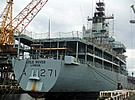Mar 04, 2013 12:00 UTC

Latest updates[?]: JHSV isn't canceled - but there will be negotiations.

Austal MRV/JHSV concept
When moving whole units, shipping is always the cheaper, higher-capacity option. Slow speed and port access are the big issues, but what if ship transit times could be cut sharply, and full-service ports weren’t necessary? After Australia led the way by using what amounted to fast car ferries for military operations, the US Army and Navy decided to give it a go. Both services leased Incat TSV/HSV wave-piercing catamaran ship designs, while the Marines’ charged ahead with very successful use of Austal’s Westpac Express high-speed catamaran. These Australian-designed ships all give commanders the ability to roll on a company with full gear and equipment (or roll on a full infantry battalion if used only as a troop transport), haul it intra-theater distances at 38 knots, then move their shallow draft safely into austere ports to roll them off.
Their successful use, and continued success on operations, attracted favorable comment and notice from all services. So favorable that the experiments have led to a $3+ billion program called the Joint High Speed Vessel. These designs may even have uses beyond simple ferrying and transport.
Continue Reading… »
Dec 20, 2012 14:18 UTC

Latest updates[?]: LPD 24 delivered; Support contract; Weapons for LPD 27.

LPD-17 cutaway
LPD-17 San Antonio class amphibious assault support vessels are just entering service with the US Navy, and 11 ships of this class are eventually slated to replace up to 41 previous ships. Much like their smaller predecessors, their mission is to embark, transport, land, and support elements of a US Marine Corps Landing Force. The difference is found in these ships’ size, their cost, and the capabilities and technologies used to perform those missions. Among other additions, this new ship is designed to operate the Marines’ new MV-22 Osprey tilt-rotor aircraft, alongside the standard well decks for hovercraft and amphibious armored personnel carriers.
While its design incorporates notable advances, the number of serious issues encountered in this ship class have been much higher than usual, and more extensive. The New Orleans shipyard to which most of this contract was assigned appears to be part of the problem. Initial ships have been criticized, often, for sub-standard workmanship, and it took 2 1/2 years after the initial ship of class was delivered before any of them could be sent on an operational cruise. Whereupon the USS San Antonio promptly found itself laid up Bahrain, due to oil leaks. It hasn’t been the only ship of its class hurt by serious mechanical issues. Meanwhile, costs are almost twice the originally promised amounts, reaching over $1.6 billion per ship – 2 to 3 times as much as many foreign LPDs like the Rotterdam Class, and more than 10 times as much as Singapore’s 6,600 ton Endurance Class LPD. This article covers the LPD-17 San Antonio Class program, including its technologies, its problems, and ongoing contracts and events.
Continue Reading… »
Dec 16, 2012 16:41 UTC

RFA Gold Rover
The UK Ministry of Defence’s concerted effort to reform its defense support operations continues. Overall, “future contracting for availability,” rather than paying for parts and labor hours, remains the overall direction. The Royal Maritime Auxiliary Service, which provided a number of services in and around the Royal Navy’s major ports, was outsourced to Serco in a GBP 1 billion December 2007 contract.
Now, a deal that could last for 30 years is providing provide through-life support for the Royal Fleet Auxiliary of Britain’s oilers, supply ships, and landing ships.
Continue Reading… »









